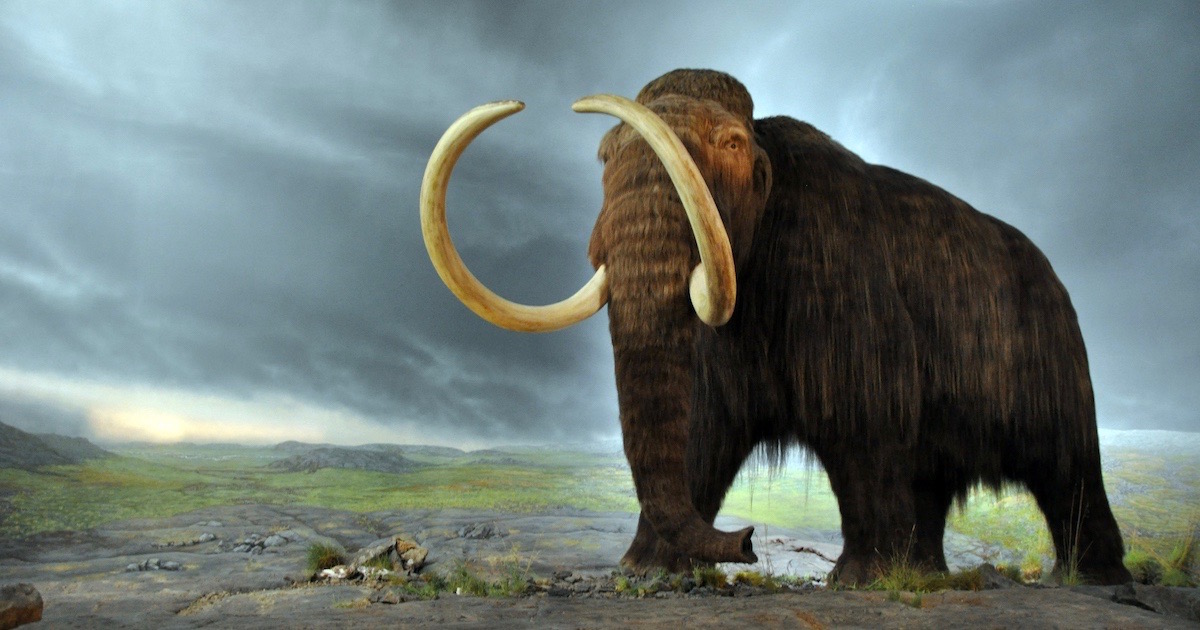 Evolution
Evolution
Evolution in Action? The End of the Woolly Mammoth


Prehistoric creatures don’t come any more poignant than mammoths. I trace my own fascination with them back to elementary school where school fieldtrips and visits with my mom took me to a Los Angeles icon, the La Brea Tar Pits, where Columbian mammoth bones stuck in the tar (actually asphalt) were being pulled out, as they still are today.
In the Ice Age, animals famously became trapped in the sticky stuff after mistaking such a pit for a watering hole. Outside the current spiffy Page Museum on the site, motorists along Wilshire Boulevard can still admire the same statuary group I recall from childhood, depicting a female mammoth trapped in the tar as an adult male and a younger mammoth, her family, look on helplessly. The idea of these great creatures, so out of place wandering what would one day be modern Southern California, gave me a melancholy sort of thrill.
Now scientists have upped the poignancy factor with a genetic description of the end of the race for mammoths. Their story played out on remote, frigid Wrangel Island, in the Arctic Ocean, where a group of perhaps 300 individuals survived, dwindling to an end as late as 2000 BC. In other words into historic times! They compared the genome of a mammoth from 45,000 years ago when the population was robust across northern Europe and Siberia, to an individual from 4,300 years ago, close to the last of its kind.
The evolution, or devolution, is heartbreaking. The Abstract from the research article in PLOS Genetics describes a population slowly falling victim to inbreeding:
Woolly mammoths (Mammuthus primigenius) populated Siberia, Beringia, and North America during the Pleistocene and early Holocene. Recent breakthroughs in ancient DNA sequencing have allowed for complete genome sequencing for two specimens of woolly mammoths (Palkopoulou et al. 2015). One mammoth specimen is from a mainland population 45,000 years ago when mammoths were plentiful. The second, a 4300 yr old specimen, is derived from an isolated population on Wrangel island where mammoths subsisted with small effective population size more than 43-fold lower than previous populations. These extreme differences in effective population size offer a rare opportunity to test nearly neutral models of genome architecture evolution within a single species. Using these previously published mammoth sequences, we identify deletions, retrogenes, and non-functionalizing point mutations. In the Wrangel island mammoth, we identify a greater number of deletions, a larger proportion of deletions affecting gene sequences, a greater number of candidate retrogenes, and an increased number of premature stop codons. This accumulation of detrimental mutations is consistent with genomic meltdown in response to low effective population sizes in the dwindling mammoth population on Wrangel island. In addition, we observe high rates of loss of olfactory receptors and urinary proteins, either because these loci are non-essential or because they were favored by divergent selective pressures in island environments. Finally, at the locus of FOXQ1 we observe two independent loss-of-function mutations, which would confer a satin coat phenotype in this island woolly mammoth.
The creamy, satiny white coat would have provided less warmth, and so you picture them succumbing, perhaps in some cases, to the elements.
The New York Times observes that the researchers “found that many genes had accumulated mutations that would have halted synthesis of proteins before they were complete, making the proteins useless.” They mention evolution only once, quoting Hendrik Poinar, an “evolutionary geneticist at McMaster University,” who notes, “This is probably the best evidence I can think of for the rapid genomic decay of island populations.”
Well, if this “genomic decay” isn’t “evolution at work,” what is it? When actually observed in the world, as opposed to in the imagination of the Darwinist, this is how evolution tends to be: things fall apart, sometimes with consequences that spell the end of a species, as happened with the mammoths, or occasionally with beneficial results. Or things stay the same, thanks to natural selection weeding out deleterious mutations. Or they vary minimally, or vary a little more dramatically only, in the end, to revert to a mean when given the chance, as Tom Bethell describes in Darwin’s House of Cards.
What evolution is never seen doing is building complex structures — new proteins, for example. That always lies beyond a distant horizon, strictly a matter — as Bethell emphasizes — of imaginative extrapolation. This theory simply cannot produce the goods it promises, try and try as it might. And that is poignant in its own way, if you think about it.
Image: Woolly mammoth, by Flying Puffin [CC BY-SA 2.0], via Wikimedia Commons.
